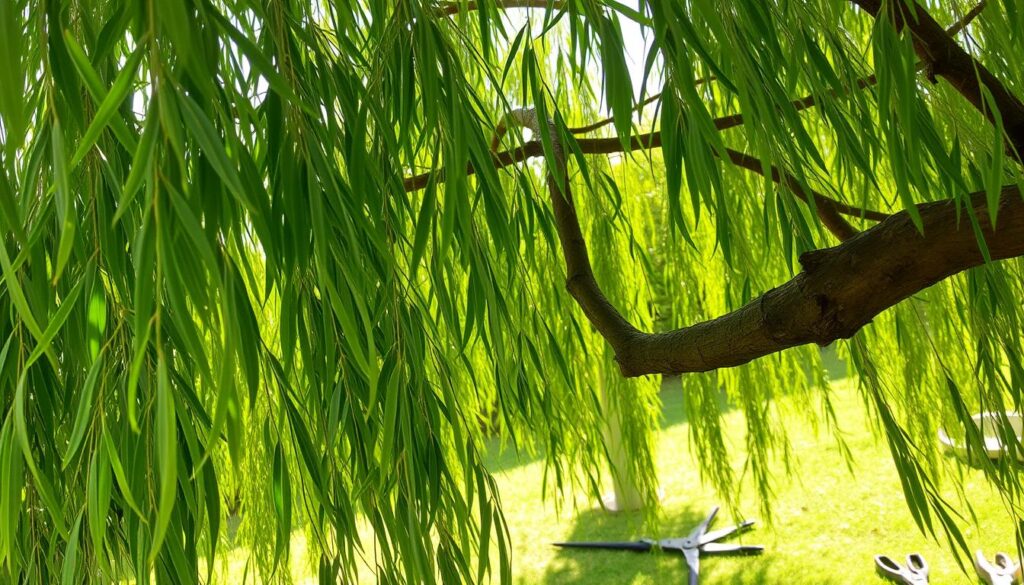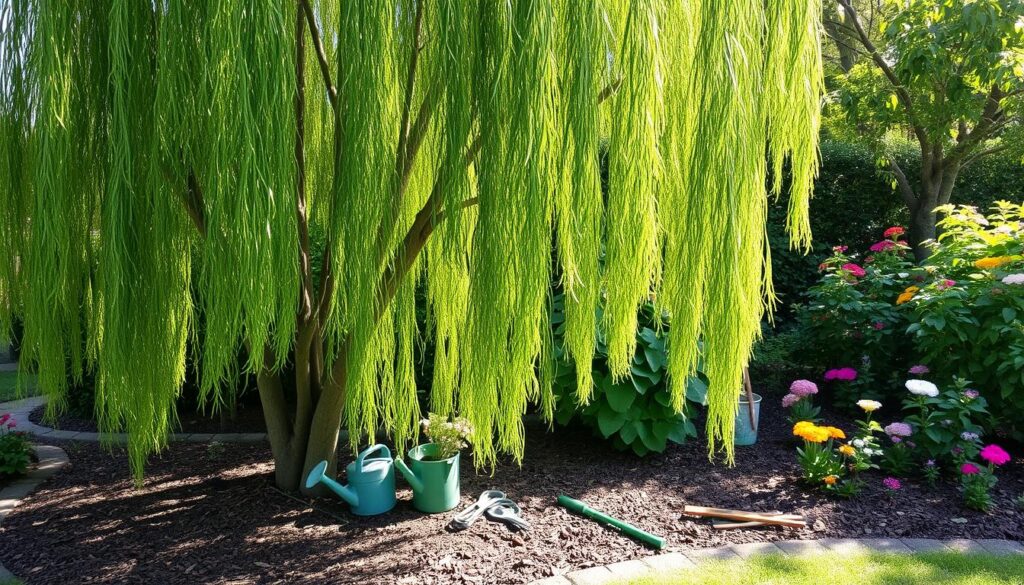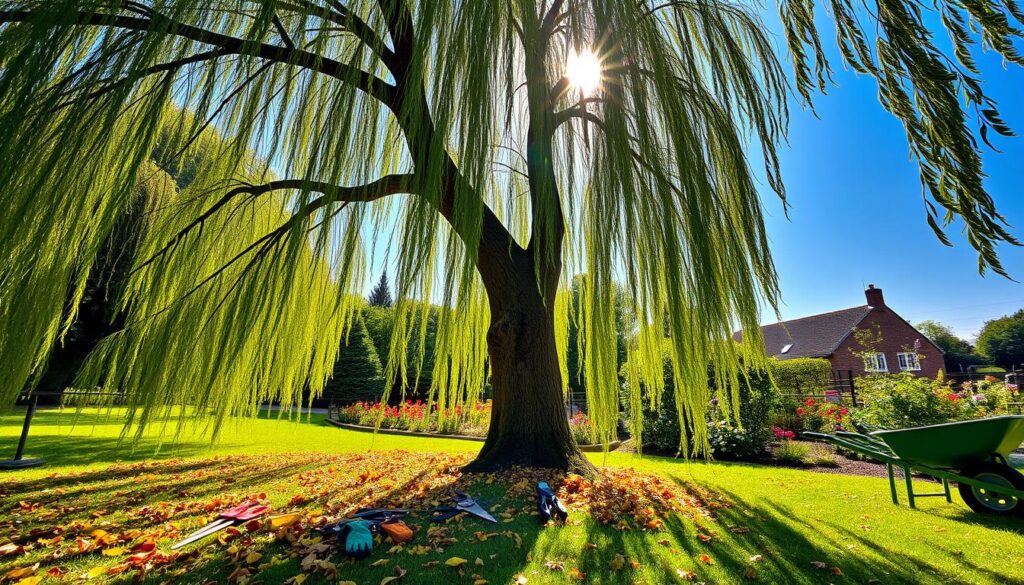Willow trees are loved for their beautiful branches and tough nature. The best time to prune them is during winter, from early to late. This is when the trees are asleep, which means less sap loss and faster healing.
This method works for both weeping and upright willows. It helps them grow strong and have beautiful branches.
Even young willows can grow strong after careful cuts. Older trees might not need much pruning unless they’re damaged or too close together.
Pruning at the right time and with the right techniques helps prevent diseases. It also improves air flow around the trunk.
Table of Contents
Key Takeaways
- Winter pruning is best to reduce sap loss.
- Young willows benefit from formative cuts.
- Mature trees need trims mainly for broken limbs.
- Healthy pruning enhances airflow and leaf growth.
- Pruning helps avoid awkward, weak branches.
Understanding Willow Tree Growth Patterns
Willow trees grow in many places, showing they can adapt quickly. There are over 400 types of Salix, all loving moist, well-drained soil. They can grow tall near rivers or in marshy spots, with a wide canopy. This knowledge helps gardeners choose the right spot and prune for health.
Natural Growth Characteristics
Most willows have strong trunks and wide roots. Some need lots of water, while others do fine with less. It’s important to give them enough space, as their roots spread far.
Common Willow Tree Varieties
The Weeping Willow is known for its long, hanging branches. Other types, like the Goat Willow, are more compact. Choosing the right one depends on your climate, yard size, and design goals. For more tips, check out this guide.
Growth Rates and Patterns
A healthy willow can grow 4 to 10 feet each year. This means they need regular checks. Their fast growth affects their branches and trunk. Understanding this helps in pruning without harming their health. This way, they grow well and look balanced over time.
Essential Tools for Willow Tree Pruning
Clean cuts help willow branches heal and stay strong. You’ll need bypass pruners for small limbs and loppers for thicker growth. Keeping blades sharp prevents ragged edges, which helps with faster healing.
It’s smart to disinfect cutting surfaces between uses to prevent disease spread.
Sturdy ladders or pole pruners are key for safe access to high spots. When climbing, make sure you have secure footing and can see the branch angle clearly. Safety goggles protect your eyes from stray twigs, and gloves keep your hands safe.
The best time to prune a willow tree is often during dormancy. But, using the right tools makes a big difference all year round.
- Bypass pruners for smaller stems
- Loppers for medium branches
- Pruning saw for thicker or older limbs
- Disinfectant to clean blades thoroughly
- Safety gear for protection
| Tool | Purpose | Maintenance |
|---|---|---|
| Bypass Pruners | Smaller branches | Sharpen regularly |
| Loppers | Moderate branch diameters | Wipe blades clean |
| Pruning Saw | Thick growth | Remove debris from teeth |
| Pole Pruner | High branches | Check secure connections |
| Safety Gear | Goggles and gloves | Inspect before each use |
Best Seasons for Willow Tree Pruning
Gardeners often plan their pruning schedule around dormancy. This protects each willow from excessive sap bleeding and pest invasions. Late winter to early spring is a safer window for shaping mature branches. These periods minimize stress, thanks to techniques for pruning willow trees that fit different climates and growth stages.
Willow varieties include around 400 species, growing up to 10 meters tall. Many prefer ample sunlight and well-drained soil. Before cutting, it’s wise to remove suckers that siphon the plant’s energy, which appear near the trunk. Visit this informative guide for more details on controlling vigorous shoots.
Spring Pruning Guidelines
Early spring pruning can address broken or weakened limbs sooner. This season suits light shaping tasks while the willow is transitioning from dormancy. A clean cut right above a healthy bud prevents unwanted regrowth.
Summer Maintenance Cuts
Summer is ideal for tiny snips to control fresh offshoots. Trimming small branches avoids sap loss while improving airflow through lush foliage. These warm months ensure rapid healing.
Winter Dormant Pruning
In colder weather, branches carry no leaves, making structural defects visible. Removing compromised areas at this time fosters healthy regrowth. Dormant cuts reduce mess and guard against sap dripping.
“Timely trimming grants willows renewed vigor and a graceful silhouette.”
| Season | Key Focus | Benefit |
|---|---|---|
| Spring | Repair damage | Encourages healthy new shoots |
| Summer | Control offshoots | Limits excess sap flow |
| Winter | Structural shaping | Reduces disease risk |
Identifying Branches That Need Removal
Understanding which limbs are weak is key to a tree’s health. Branches with V-shaped junctions are more likely to break in the wind. Removing dead or diseased wood helps prevent infection and improves airflow.
Weeping willows can grow fast, up to two feet a year. This can lead to moisture buildup and fungal problems if not managed. Pruning in late winter is best because the tree is dormant. This helps it recover better when spring comes.
Some gardeners remove branches that grow downwards, blocking paths or driveways. Keeping a single trunk can prevent structural problems and ensure the tree lasts longer. For more tips, check out these expert guidelines on pruning.

“A clean cut helps shape balanced canopies that endure seasonal stress.”
- Assess weak junctions or rubbing limbs
- Clip dead or storm-damaged branches
- Watch for signs of discoloration or fungal spores
| Branch Type | Reason for Removal |
|---|---|
| Dead or Diseased | Avoids further decay |
| Crossing Limbs | Improves airflow |
| Weak V-Shaped Unions | Prevents breakage |
| Obstructive Growth | Maintains safe clearance |
Basic Willow Tree Pruning Techniques
Willow trees grow up to 10 feet a year. To keep them strong, it’s important to shape them right. Cutting off weak limbs and improving air flow are key. Using clean pruning tools helps prevent disease and makes cutting easier.
Heading Cuts vs. Thinning Cuts
Heading cuts shorten branches to control growth. Thinning cuts remove limbs to prevent overcrowding. Both help manage the tree’s shape by removing unwanted parts.
Proper Cutting Angles
Making angled cuts helps water drain away from the cut area. This reduces the risk of decay and disease. Sharp, swift cuts heal faster.
Branch Collar Protection
The branch collar is a protective zone at the base of each limb. Keeping it intact prevents damage and promotes healthy growth. Regular pruning with the right tools keeps the tree balanced.
| Branch Diameter | Recommended Tool | Cutting Advantage |
|---|---|---|
| Up to 3/4 inch | Pruning Shears | Ideal for light twigs |
| Up to 2 inches | Loppers | Better leverage for medium limbs |
| Over 2 inches | Handsaw | Ensures smooth removal of heavy branches |
Shaping and Training Young Willow Trees
Young willow trees need steady guidance to grow well. This helps them develop a balanced canopy and a strong trunk. Early shaping can prevent problems and save time later.
Main limbs should be well-spaced for good airflow. This helps fight off fungal diseases. Thinning out competing shoots helps the tree grow stronger.
Expert tips for willow tree pruning say to remove branches that rub. Keeping healthy lateral shoots makes the tree fuller. This method supports fast growth and cuts disease risk by up to 50%.
Here’s a simple guide for early trimming:
| Year | Key Pruning Task | Expected Outcome |
|---|---|---|
| 1 | Establish central leader | Promotes straight trunk |
| 2 | Select strong lateral branches | Increases airflow and branch spacing |
| 3 | Remove crossing stems | Reduces weak angles and disease risk |
Expert tips for willow tree pruning show that early shaping makes a tree strong and beautiful.
Managing Mature Willow Tree Growth
Large willows can grow up to 34 to 45 feet tall. Their crowns can spread just as wide. Taking care of their upper canopy is key to keeping them beautiful and stable.
Regular care helps older willows thrive. Light pruning keeps their shape elegant. Pruning also makes them safer during storms and keeps their canopy healthy.
Crown Reduction Methods
Pruning the outer branches helps the tree grow evenly. Cutting 10% to 15% off is usually enough. This method keeps the tree’s unique shape and helps it heal quickly.
Dealing with Heavy Branches
Heavy branches can harm the tree’s structure. It’s important to remove them carefully. This makes the tree stronger and less likely to break in the wind.
Height Control Strategies
Mature willows can grow up to 10 meters. Pruning the top shoots controls their size. Regular pruning keeps the tree looking good and safe.
Post-Pruning Care and Recovery
After trimming, trees need ongoing care to heal well. Clean cuts heal faster with extra steps for healthy growth. Applying pruning sealant to big wounds helps prevent infection. Also, watering well supports the tree’s recovery.
Light fertilizing helps if the tree lost a lot of leaves. It’s important to check for pests and fungi regularly. Dead or sick branches should be removed quickly to keep the tree strong. Cutting off root suckers helps keep nutrients for the main parts of the tree.

Watching the tree closely is key. Seeing lots of new shoots means it’s healing well. But, not seeing new leaves might mean there’s a bigger issue. Focus on gradual shaping and a stress-free environment for long-term health.
- Check soil moisture regularly
- Monitor the bark for signs of damage
- Trim new suckers to redirect energy
| Care Step | Description |
|---|---|
| Seal Cuts | Use proper sealant to block pathogens entering large cuts |
| Fertilize Lightly | Apply balanced nutrients to boost healing and stimulate fresh leaves |
| Monitor Growth | Check weekly for healthy sprouts and remove any weak or discolored segments |
Propagating Willow Trees from Pruned Branches
Leftover stems are a simple way to get new saplings. This method stops waste and makes landscapes healthier. Many gardeners love Dappled Willow for its bright leaves. Weeping Willow cuttings also grow well under similar conditions.
Clippings of 6 to 8 inches are common. Place 2 to 3 inches below the soil. Most will sprout if kept moist. But, some might not root.
Many prefer late winter through May for planting. This is because cooler temperatures help the saplings grow better.
Cutting Selection
Strong, pencil-thick sections work best. Gardeners often remove half of the leaves near the base.
- Look for newer growth that’s firm
- Avoid diseased or weakened stems
- Choose material free of insect damage
Rooting Methods
Some use water until root filaments appear. Others plant cuttings directly in well-draining soil. Root establishment within four weeks is typical. But, it may take longer in hotter climates.
- Place cuttings in clean water or damp potting mix
- Monitor consistently to prevent dryness
- Provide moderate daylight and avoid scorching heat
Care for New Cuttings
Young shoots need consistent moisture and partial shade. Eco-friendly gardeners reuse nutrient-rich “Willow Water” on other plants. After a year, these saplings are strong and ready for outdoor planting.
Long-term Willow Tree Maintenance Strategy
Keeping willow trees healthy and looking good all year takes regular care. Salix trees come in many shapes and sizes, but they all need consistent water and food. Taking care of them also keeps pests like caterpillars and willow beetles away.

Maintaining an organized plan helps avoid sudden surprises and costly treatments.
Annual Care Calendar
Having a routine is key for healthy growth. Tasks include:
- Light pruning in late winter to remove weak or damaged limbs
- Applying a balanced 10-10-10 fertilizer before spring growth
- Mulching around the base to preserve soil moisture
It’s important to water them well when it’s dry. This helps keep the soil moist. Checking the soil regularly prevents roots from getting too wet or dry.
Growth Monitoring Tips
Watching your tree closely helps spot problems early. If leaves turn color or wilt, it might be a sign of disease or lack of nutrients. Look for pests on branches and remove any suckers that harm the main trunk.
Professional Assessment Guidelines
For big damage or structural issues, get help from an arborist. They can suggest special treatments or precise pruning. Getting expert advice when needed keeps your willow tree healthy and beautiful for years.
Mastering the Art of Willow Tree Care
Willow trees are part of the Salicaceae family, with over 400 species. They add beauty to places like riverbanks, gardens, and landscapes. To keep them thriving, focus on watering, soil care, and pruning at the right time.
They do best in USDA Hardiness Zones 4 through 9. They need at least six hours of direct sunlight daily.
Prune dappled willows in late winter or early spring. This helps shape their growth and removes damaged branches. Use sharp tools to avoid harming the tree.
Young willows need deep watering, while older ones need less. Plant them 20 to 40 feet apart to give them room to grow.
Regularly check your trees and act quickly if needed. Watch for pests, use balanced fertilizer, and prune carefully. This way, your willow trees will grow strong and beautiful.
FAQs About Pruning and Caring for Willow Trees
When should I prune a willow tree?
The best time to prune a willow tree is in late winter or early spring before new growth starts. This helps the tree heal quickly and reduces the risk of disease. Avoid heavy pruning in the fall, as open wounds may not have enough time to close before winter.
How do you shape willow branches?
To shape willow branches, trim back any long or unruly growth, focusing on maintaining a balanced shape. Use sharp pruning shears and make clean cuts just above a bud or branch junction. If you want a more rounded or weeping shape, selectively remove upward-growing branches while encouraging lateral growth.
Do willow trees need fertilizer?
Yes, but they don’t need much. Willows grow fast and can thrive in nutrient-rich soil. If growth seems slow or leaves appear pale, apply a balanced fertilizer (like 10-10-10) in early spring. Avoid over-fertilizing, as too much nitrogen can lead to weak branches.
How to cut back a weeping willow tree?
Start by removing any dead, damaged, or diseased branches. Trim back long or drooping branches to keep the shape balanced, making cuts at a slight angle just above a bud. If needed, thin out the canopy to allow more light and air circulation.
Can you cut the top off a willow tree in the summer?
It’s not ideal. Cutting the top off a willow tree in summer can cause stress and excessive sprouting. If you must prune in summer, stick to light trimming, removing only small branches. Major cuts should be done in late winter or early spring.
Can you cut a branch off a willow tree and plant it?
Yes! Willows root easily from cuttings. Take a healthy branch (about 12-18 inches long), remove the lower leaves, and place it in a container of water. After a few weeks, roots should appear, and you can plant it in soil. Keep it moist while it establishes itself.

